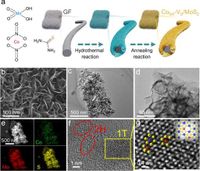In a significant advancement for energy storage technology, researchers have developed a new type of aqueous redox flow battery (RFB) utilizing a unique nanostructured catalyst. This innovation combines a defective molybdenum disulfide (MoS2) support embedded with cobalt single atoms. The resultant polysulfide-iodide redox flow battery, referred to as CoSA-VS/MoS2, has demonstrated impressive initial energy efficiency (EE) of 87.9% and a peak power density of 95.7 mW cm-2. Moreover, the battery maintains its performance over an extensive cycling life, exhibiting over 850 cycles while retaining 62% EE.
The global energy crisis has prompted a renewed focus on sustainable solutions, particularly in energy storage. Redox flow batteries are gaining traction due to their high scalability, design flexibility, and safety. Aqueous systems utilizing sulfide/polysulfide and iodide/triiodide couples are particularly attractive thanks to their high solubility and low cost. However, previous designs suffered from sluggish charge transfer reactions that limited their efficiency and overall effectiveness.
The novel design of the CoSA-VS/MoS2 battery addresses this issue by optimizing the redox kinetics of the S2−/Sx2− and I−/I3− couples through the introduction of cobalt single atoms, which promote the formation of sulfur vacancies in the MoS2 structure. According to the study published in Nature Communications, the initial energy efficiency was notably higher than other metal sulfide catalysts previously tested, such as CoS2 and Cu7S4.
Researchers employed in situ experimental methods and density functional theory (DFT) calculations to unveil the mechanisms behind the enhanced performance of the developed catalyst. This included observing a phase transformation in MoS2, which further improved the catalytic properties necessary for efficient electron transfer during the redox reactions.
One key advantage of the CoSA-VS/MoS2 system is its ability to reach and maintain high energy efficiencies over an extensive range of operating conditions. In tests, the system exhibited an average EE of 80.4% across a cycling life of more than 850 cycles. The battery also demonstrated a low overpotential of 113 mV at a current density of 20 mA cm-2, indicating reduced energy losses during operation.
The research highlights that the enhanced reactivity and stability of the CoSA-VS/MoS2 battery make it a promising candidate for practical applications, particularly in intermittent energy storage systems that support renewable energy sources. This research not only advances the field of aqueous RFB technology but also contributes to the search for sustainable and economical energy solutions.
As the world shifts towards renewable energy, innovations like the CoSA-VS/MoS2 battery may play a pivotal role in addressing energy storage challenges. The continued exploration of single-atom catalysts and novel electrode materials promises to drive efficiency and sustainability in energy storage applications.




